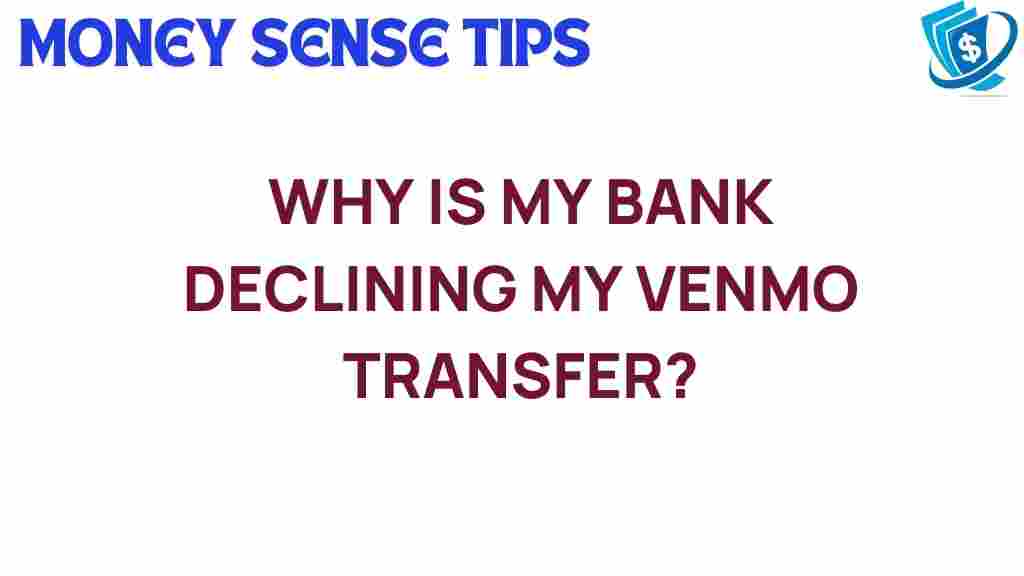Unraveling the Mystery: Why Is Your Bank Declining Venmo Transfers?
In today’s fast-paced digital world, platforms like Venmo have revolutionized how we handle money transfers. However, many users face the perplexing issue of their bank declining Venmo transactions. This article delves into the reasons behind such declines, helping users understand the intricacies of digital payments, banking policies, and enhancing the overall user experience.
Understanding Venmo and Its Popularity
Venmo is a user-friendly mobile payment service that allows individuals to transfer money to one another quickly. Its social media-like interface and seamless integration with bank accounts make it a favorite among millennials and Gen Z. However, despite its popularity, users sometimes encounter transaction issues that can be frustrating.
How Venmo Transactions Work
Venmo transactions typically involve the following steps:
- Link your bank account or debit card to your Venmo account.
- Select the recipient and the amount you wish to send.
- Confirm the transaction and add a note if desired.
- The funds are transferred instantly from your account to the recipient’s account, often with no fees for personal transactions.
However, this process is not always smooth. The simplicity of Venmo can lead to confusion when banks decline transactions.
Common Reasons for Bank Decline in Venmo Transfers
Understanding why your bank may decline a Venmo transfer can help you mitigate these issues in the future. Here are some common reasons:
- Insufficient Funds: The most straightforward reason for a bank decline is having insufficient funds in your linked account.
- Banking Policies: Each bank has its policies regarding digital payments, and some may flag Venmo transactions as suspicious.
- Transaction Limits: Banks often impose limits on the amount you can transfer, which can lead to declines if you exceed these limits.
- Security Measures: Banks may decline transactions that they deem unusual or potentially fraudulent, especially if they involve significant amounts.
- Technical Issues: Sometimes the failure is due to technical problems either on Venmo’s end or your bank’s system.
Step-by-Step Process: How to Troubleshoot Venmo Declines
If you find your Venmo transactions being declined, follow these steps to troubleshoot the issue:
- Check Your Balance: Ensure you have sufficient funds in your linked bank account or debit card.
- Review Your Transaction Limits: Familiarize yourself with your bank’s transaction limits and ensure you are within them.
- Contact Your Bank: Reach out to your financial institution to inquire about any holds or policies affecting your account.
- Update Your Payment Method: If your primary payment method is causing issues, consider adding a different bank account or debit card.
- Verify Your Venmo Account: Make sure your Venmo account is fully verified, as unverified accounts may face restrictions.
- Check for Outages: Occasionally, Venmo may experience outages that affect transactions. Check their status page for updates.
Banking Policies Impacting Venmo Transfers
Each bank has its unique set of policies regarding digital payments. Some may prioritize security over convenience, leading to more frequent declines. Here are a few aspects of banking policies that can affect your Venmo experience:
- Fraud Detection: Banks employ algorithms to detect unusual spending patterns, which can inadvertently flag legitimate transactions.
- Linking Accounts: Some banks may have strict regulations on linking third-party payment services.
- Transaction Types: Certain banks may only allow specific types of transactions or may charge fees for digital transfers.
Enhancing Your User Experience with Venmo
To improve your experience while using Venmo and minimize transaction issues, consider the following tips:
- Update Your App: Ensure you are using the latest version of the Venmo app to benefit from improvements and bug fixes.
- Regularly Monitor Your Account: Keep an eye on your linked accounts and transactions to spot any discrepancies early.
- Diversify Payment Methods: Link multiple payment sources to your Venmo account for flexibility.
- Use Venmo for Small Transactions: If your bank imposes strict limits, use Venmo primarily for smaller amounts.
- Stay Informed: Follow updates from your bank regarding their policies on digital payments.
Conclusion
Understanding the reasons behind bank declines in Venmo transfers can significantly enhance your experience with digital payments. By recognizing the common issues and following the troubleshooting steps outlined above, you can navigate the complexities of money transfers with greater confidence. Always remember to stay informed about your bank’s policies and the latest updates from Venmo to ensure a smooth transaction process.
For more insights into managing your finances in the digital age, consider exploring additional resources.
By taking proactive steps, you can enjoy the benefits of Venmo without the hassle of unexpected declines.
This article is in the category Services and created by MoneySenseTips Team
